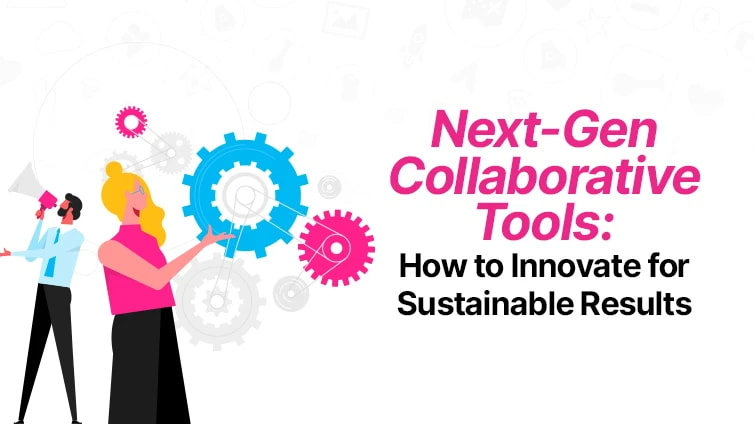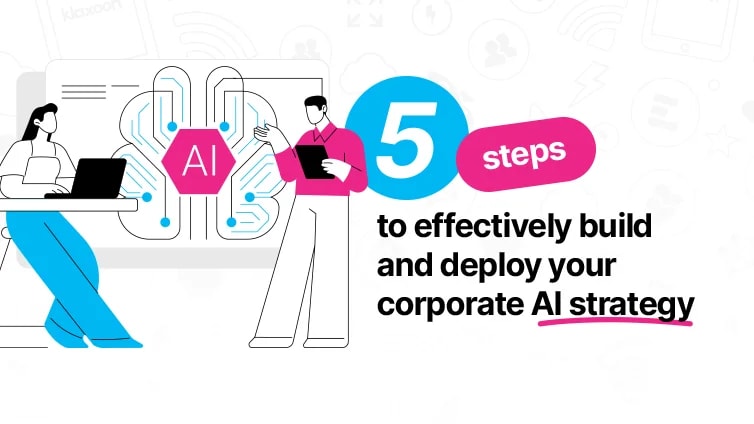5 ways to improve visual collaboration with AI
Executive summary:
Artificial intelligence (AI) applied to visual collaboration promises a new lease of life for teamwork. In a context where organizations are increasingly hybrid, multicultural, and dispersed, it is becoming essential to streamline exchanges, value each contribution, and quickly transform ideas into concrete actions.
How does this play out in reality? Even with the advanced visual tools available today, some ideas may be overlooked, different viewpoints may not be fully explored, and translating ideas into action plans can be difficult. Language barriers, distance, and the sheer volume of contributions can hinder collective efficiency.
The solution to this? Leverage artificial intelligence to amplify the power of visual collaboration.
Together, AI and visual collaboration pave the way for more engaged, innovative, and effective teams. With AI, you can transform your work practices in a variety of ways:
- Automatically group and structure ideas for greater transparency and clarity in your exchanges.
- Highlight diverse points of view by valuing every contribution, even minority ones.
- Generate concrete action plans from shared ideas to accelerate the transition to experimentation.
- Streamline hybrid and asynchronous collaboration by facilitating the handover of topics and ensuring everyone is on the same page.
- Adapt the collaboration experience to the needs of each team for greater personalization and agility.
By integrating AI into your collaborative practices, you enable your teams to become more flexible, better capitalize on collective intelligence, and transform every exchange into a real performance lever.
Visual collaboration has emerged in recent years as an essential lever for stimulating creativity, engagement, and team efficiency. Thanks to innovative digital tools, it is now possible to share ideas, structure projects, and make collective decisions anytime, anywhere.
These solutions have already transformed the way we work together. However, a new era is now dawning: the era of artificial intelligence.
Far from undermining the achievements of visual collaboration, AI actually increases its potential tenfold. It allows us to go further, faster, and dare to do what seemed difficult yesterday:
- Explore new perspectives;
- Personalize each team's experience;
- Streamline exchanges beyond the constraints of time and space,...
For managers and decision-makers, this is an opportunity to offer their teams an even more engaging, inclusive, and efficient work environment. The combination of AI and visual collaboration is profoundly redefining the way ideas emerge, circulate, and take shape in all types of organizations.
Together, let's explore how the combination of AI and visual collaboration paves the way for new boldness and enables unprecedented efficiency. Are you ready to take the plunge?
1. Dare to be more transparent
Visual collaboration already makes teamwork more transparent and fluid in many ways. This is achieved through several complementary interactive activities:
- Online whiteboards;
- Structured mind maps;
- Interactive quizzes;
- Gamified pathways;
- Unlimited digital workspaces, etc.
All these tools give teams the ability to visualize the progress of their projects, track the evolution of their ideas, and exchange feedback quickly and efficiently.
However, in reality, this transparency is not always complete:
- Some ideas can get lost in the crowd;
- Blocking issues may go unnoticed;
- Ideas can be difficult to structure so that they are clearly understood by everyone.
In cases like these, artificial intelligence can complement the power of visual collaboration and help you reveal and clarify certain aspects of your collaboration with complete transparency.
For example, thanks to advanced AI features for grouping and categorizing ideas, everyone's contributions can be instantly organized by theme. This smart sorting reveals trends, highlights original ideas that might have otherwise gone unnoticed, and provides each participant with a clear view of the collective dynamic.
AI can also suggest groupings of ideas that you might not have thought of at first glance, which can happen in cross-functional collaboration workshops or co-construction between multiple departments.
Another concrete example is the automatic translation of contributions using AI. In international or multicultural teams, AI can become a lever that allows everyone to express themselves in their own language, while ensuring immediate and fluid understanding for all. This ability to break down language barriers reinforces transparency and inclusion, giving each voice the same reach regardless of context.
2. Embrace diverse perspectives
A diversity of profiles, experiences, and sensibilities is essential for generating a wealth of ideas in any team. However, even with the best visual collaboration tools, some voices may still be left out, or group dynamics may unconsciously favor majority opinions.
Artificial intelligence, when integrated into these workspaces, is an effective way to change the game.
For example, by allowing you to group or sort all your contributions on a collaborative whiteboard, it can save you time on these steps, giving more participants the opportunity to share their ideas and opinions.
In addition, the ability to structure your ideas according to different themes or categories makes it easier to read and understand all contributions, even when there are many of them or they come from a variety of profiles. This draws attention to minority viewpoints and suggestions that might have been overlooked in an unstructured flow of ideas.
In workshops, this ability to classify and summarize everyone's contributions encourages the emergence of new perspectives. Participants can more easily build on ideas from outside their own field and draw inspiration from suggestions of other departments and professions. AI thus acts as a facilitator, encouraging the expression of all voices and valuing the diversity of contributions.
Thanks to these features, every participant can feel empowered to share their ideas, regardless of their experience or background, and contribute fully to the collective success.
In short, when integrated into visual collaboration, artificial intelligence does more than just make diversity visible. It structures and values diversity, giving it its rightful place in the team dynamic.
3. Experiment without limits
Innovation often stems from the ability to test, explore, and quickly adjust ideas. However, in the reality of collaboration, it is not always easy to transform a multitude of contributions into concrete actions, or to dare to experiment with new avenues without fear of wasting time or spreading oneself too thin.
This is where artificial intelligence, integrated with visual collaboration, can be a real lever for efficiency.
By automatically grouping and categorizing shared ideas in your interactive workspace, AI allows you to instantly clarify the different options that emerge during a brainstorming or problem solving session. This makes it easier to compare, prioritize, and select the avenues to explore.
With certain AI-powered visual collaboration tools, you can also generate an action plan from a selection of ideas, transforming collective thinking into concrete, actionable steps.
This allows you to move more quickly from ideation to experimentation by clearly identifying the actions to be taken, who is responsible, and when. Teams gain agility and efficiency while keeping the freedom to adjust their plan based on feedback and learning.
Finally, automatic translation of contributions continues to play a key role in this experimentation dynamic, allowing everyone to take ownership of ideas from the entire group, regardless of their language. This promotes everyone's involvement and encourages initiative, even in multicultural contexts.
Daring to experiment without limits means leveraging the complementary nature of AI and visual collaboration to turn ideas into action, while cultivating an environment conducive to innovation and collective learning.
4. Embrace hybrid and asynchronous collaboration
Hybrid and remote working have become the new norm, but they raise many challenges: how can you keep everyone engaged, ensure continuity of communication, and guarantee that every idea is taken into account, even when teams are not sharing the same office or time zone?
Artificial intelligence, integrated into visual collaboration tools, offers concrete answers to these challenges. When a team works asynchronously, AI allows it to gather and structure the ideas exchanged in a centralized workspace, even if they were shared at different moments.
This means that every contribution is valued and integrated into the collective thinking, without anything getting lost in the flow of exchanges.
AI's ability to structure ideas also makes it easier to resume discussions after a break or a change of participants: everyone can quickly understand the progress made, the topics discussed, and the key points without having to go once more through the entire exchange. This increases efficiency and avoids repetition, while encouraging active participation, even outside of synchronous meeting times.
Finally, generating an action plan from a selection of ideas allows asynchronous exchanges to be quickly transformed into concrete, shared decisions. Even when working remotely, every team member knows what they have to do, which promotes autonomy and accountability.
Embracing hybrid and asynchronous collaboration means leveraging AI in your visual collaboration to streamline your exchanges, value every contribution, and ensure collective efficiency, regardless of where team members are located or how fast they work.
5. Foster personalization and scalability
In a professional context where teams are increasingly diverse and projects increasingly complex, the ability to personalize the collaboration experience is becoming a real asset.
However, it is not always easy to adapt working methods to the specific needs of each group or situation, especially when contributions are numerous and varied.
Artificial intelligence, when integrated with visual collaboration, takes personalization to the next level. By automatically organizing your ideas, AI allows you to create structured workspaces tailored to each project, each team, or even each stage of a process.
Participants can easily navigate between different topics, quickly find the ones that matter to them, and focus on their priorities.
Generating an action plan from a selection of ideas also makes it possible to tailor project monitoring to the team's actual needs. Each plan is unique, built from the group's contributions, and can be adjusted in real time based on feedback and project developments. This flexibility promotes everyone's engagement and enables a more effective response to unforeseen events or changes in direction.
Finally, AI-powered automatic translation contributes to this personalization by allowing everyone to express themselves in their own language, regardless of the context or composition of the team. This ensures that every member feels included and can participate fully, without fear of judgment.
Daring to personalize and adapt on a large scale means leveraging AI to offer each team a tailored, fluid, and scalable visual collaboration experience that can constantly adjust to the needs and ambitions of the group.
Conclusion
Artificial intelligence, combined with visual collaboration, can truly increase teamwork efficiency tenfold. This way of working paves the way for more inclusive, agile, and effective collective practices.
By facilitating the structuring, translation, and transformation of ideas into concrete actions, it enables organizations to dare more: more transparency, more diversity, more experimentation, more flexibility, and more personalization.
With the combined power of these tools, managers and decision-makers in companies now have powerful levers to engage their teams, stimulate innovation, and adapt to the growing complexity of their projects and challenges.
Unlock your teamwork potential
For free, make your first steps to top-tier work efficiency with the Klaxoon Work Collaboration Platform.


